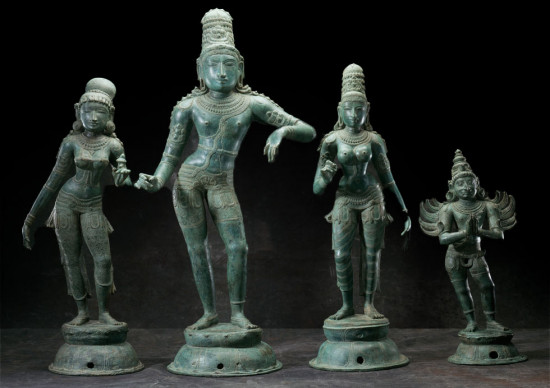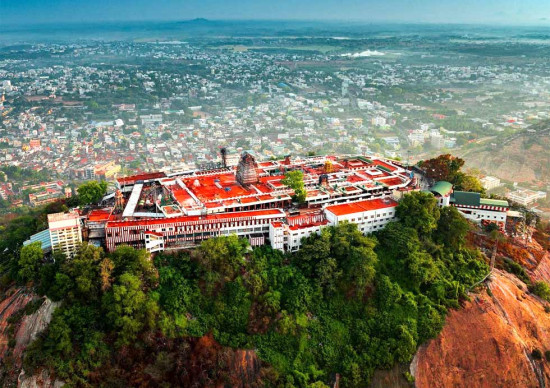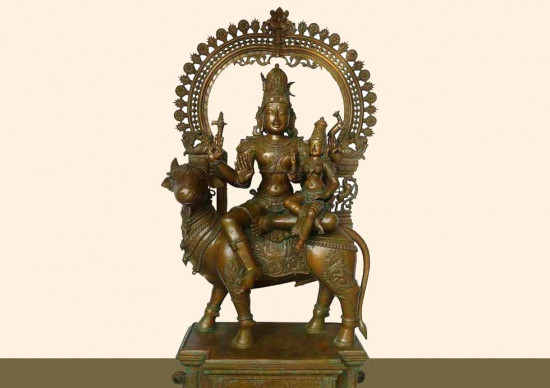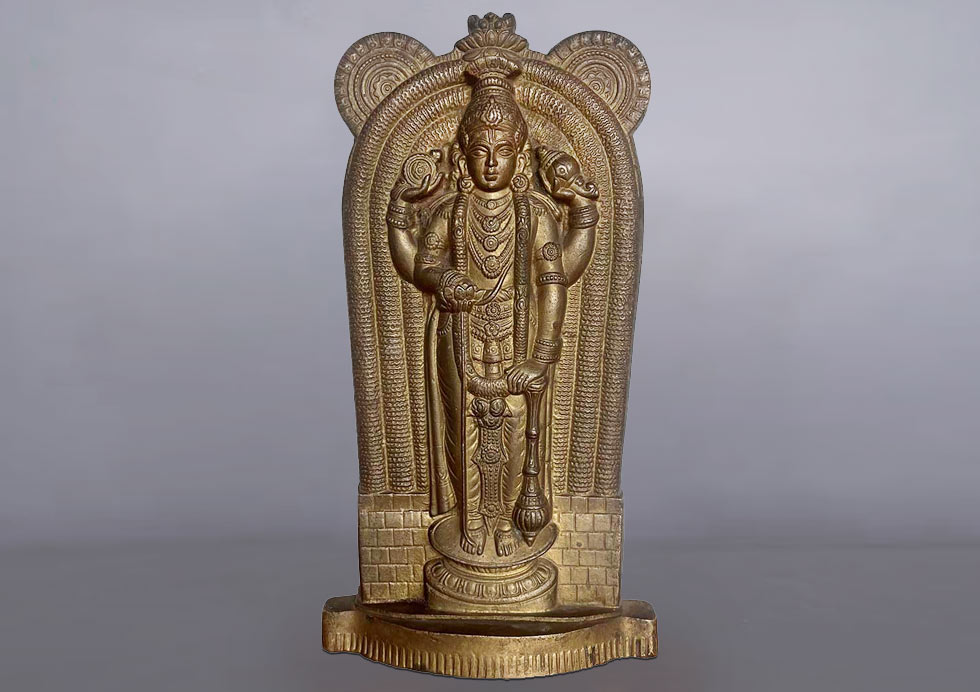
With a history rooted in the depths of time, Guruvayur is believed to be around 5,000 years old, mirroring the age of the revered Guruvayur temple idol. The narrative unfolds as Lord Krishna directs two sages to rescue his idol from the crumbling city of Dwarka, entrusting it to the hands of Vayu Deva and Brhaspathi, who establish it in the tranquil landscapes of Kerala. The very name “Guruvayur” emerges from the amalgamation of their divine identities. Journey through the centuries, from the references in ancient Tamil literature to the 16th-century mentions, as the story unfolds the rich tapestry of Guruvayur’s cultural and religious heritage. Immerse yourself in the significance of Guruvayurappan, an embodiment of Lord Vishnu in his Sampoorna Avatar form, radiating divine charm with four lustrous arms and timeless attributes. Uncover the spiritual legacy of Guruvayur, where the Lord, adorned with a Tulasi garland, stands as the eternal “Father of Guruvayur,” beckoning devotees to witness the heavenly abode of Sri Krishna.
Divine Journey: Guruvayur's Timeless Tale
Long, long ago, at the dawn of Padma Kalpa (a time period in Hinduism), during the celestial dance of creation by Brahma, a heartfelt desire for liberation echoed in his creations. Then Lord Vishnu gave an idol of his own to Lord Brahma. This sacred effigy held the promise of mukti (liberation), free from the shackles of karma.
Brahma, the creator deity, received this divine sculpture with gratitude. In the subsequent Varaha Kalpa, he passed this precious idol to a devoted sage named Sutapas and his wife Prashni. The couple, immersed in meditation and seeking the divine boon of parenthood, continued their prayers with utmost devotion.
Their unwavering faith bore fruit when Vishnu, moved by their sincerity, manifested before them. Responding to their heartfelt wish for a son resembling him, Vishnu made a profound promise. Across three successive births, he would be born as their son, allowing them the privilege of worshiping the sacred idol in each life.
Brahma, the creator deity, received this divine sculpture with gratitude. In the subsequent Varaha Kalpa, he passed this precious idol to a devoted sage named Sutapas and his wife Prashni. The couple, immersed in meditation and seeking the divine boon of parenthood, continued their prayers with utmost devotion.
Their unwavering faith bore fruit when Vishnu, moved by their sincerity, manifested before them. Responding to their heartfelt wish for a son resembling him, Vishnu made a profound promise. Across three successive births, he would be born as their son, allowing them the privilege of worshiping the sacred idol in each life.
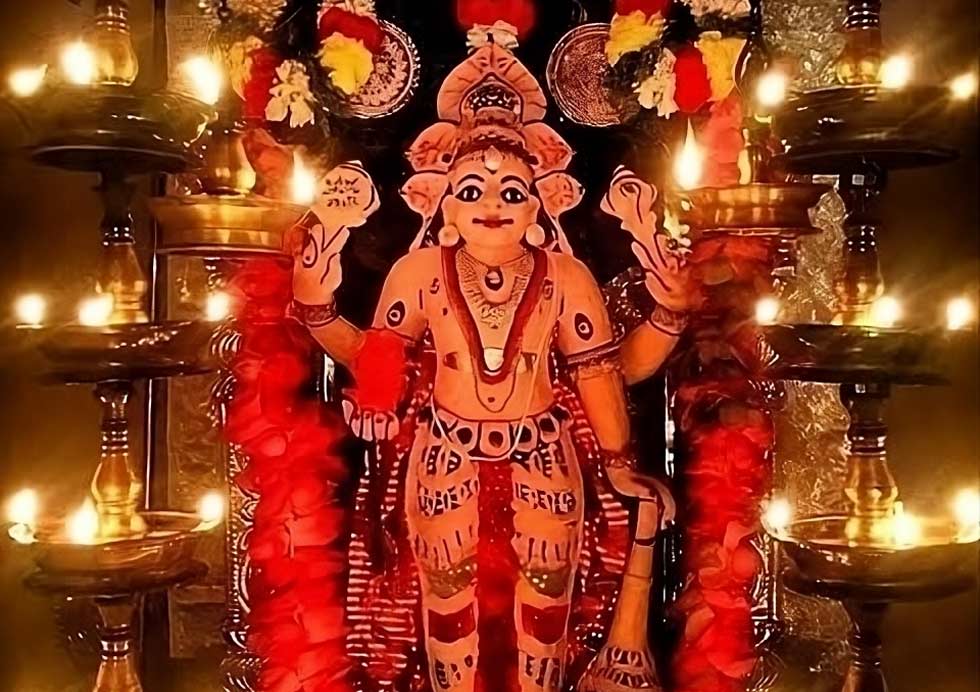
In the Satya Yuga, as Prsnigarbha, Vishnu guided Dhruva and created Dhruvaloka. In the Treta Yuga, he was Vamana, born to Kashyapa and Aditi. Finally, in the Dvapara Yuga, as Krishna, the eighth son of Vasudeva and Devaki, Vishnu fulfilled his promise to be born to those who worshiped his sacred idol.
After his studies, Krishna took the idol to Dvaraka, building a temple and worshiping it despite being Vishnu’s avatar. As the Dvapara Yuga ended, Vishnu revealed a coming deluge. He entrusted the idol’s safety to Uddhava, who sent it to Brihaspati (guru)and left for penance in Badrikashram.
True to Vishnu’s prophecy, Dvaraka succumbed to a deluge, with only a mountain’s peak surviving. Brihaspati, guided by Vayu, retrieved the idol with the help of Varuna and faced an encounter with Parashurama. They journeyed south to Guruvayur, where Shiva and Parvati awaited.
Guruvayur, deemed divine by Shiva, became the perfect spot for the idol installation. Brihaspati and Vayu, with guidance from Vishvakarma, erected a temple. Shiva performed the first pooja, and Guruvayurappan, the ‘God of Guruvayur,’ found his home in “Bhuloka Vaikuntha.”
The story reached Janamejaya, who visited Guruvayur with his family, worshiping Vishnu and Shiva. His devotion culminated in a darshana of Krishna, curing his ailment.
After his studies, Krishna took the idol to Dvaraka, building a temple and worshiping it despite being Vishnu’s avatar. As the Dvapara Yuga ended, Vishnu revealed a coming deluge. He entrusted the idol’s safety to Uddhava, who sent it to Brihaspati (guru)and left for penance in Badrikashram.
True to Vishnu’s prophecy, Dvaraka succumbed to a deluge, with only a mountain’s peak surviving. Brihaspati, guided by Vayu, retrieved the idol with the help of Varuna and faced an encounter with Parashurama. They journeyed south to Guruvayur, where Shiva and Parvati awaited.
Guruvayur, deemed divine by Shiva, became the perfect spot for the idol installation. Brihaspati and Vayu, with guidance from Vishvakarma, erected a temple. Shiva performed the first pooja, and Guruvayurappan, the ‘God of Guruvayur,’ found his home in “Bhuloka Vaikuntha.”
The story reached Janamejaya, who visited Guruvayur with his family, worshiping Vishnu and Shiva. His devotion culminated in a darshana of Krishna, curing his ailment.
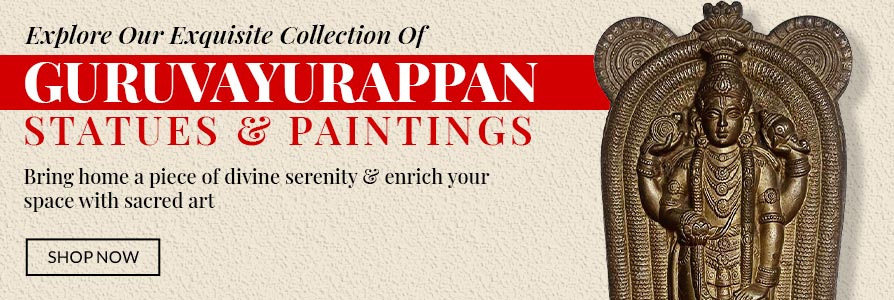
The story reached Janamejaya, who visited Guruvayur with his family, worshiping Vishnu and Shiva. His devotion culminated in a darshana of Krishna, curing his ailment.
King Janamejayais the son of King Parikshit (son of Abhimanyu and grandson of Arjuna). King Parikshit, bitten by the snake Takshaka, met a tragic end. Seeking revenge, his son Janamejaya conducted a snake sacrifice, but Takshaka survived due to immortality. But many innocent snakes died in this sacrifice and as a result of that King Janamejaya, affected by a snake curse, suffered from incurable leprosy. Sage Atreya advised him to worship Vishnu in Guruvayur, where divine grace healed him, showcasing the power of redemption and forgiveness.
Amid Guruvayur’s lore, a regional myth unfolded about a king saved from a cobra bite through the deity’s grace. Grateful, the king built the temple and funded its daily routine.
The Guruvayur temple, with roots in the 16th and 17th centuries, stands as a testament to devotion. The deepastamba, erected in 1836, illuminates the temple, welcoming devotees from Thiruvananthapuram. Gopurams in the east and west, inscribed with historical significance, showcase the timeless journey of Guruvayur, a haven offering solace in the troubles of the Kali Yuga.
King Janamejayais the son of King Parikshit (son of Abhimanyu and grandson of Arjuna). King Parikshit, bitten by the snake Takshaka, met a tragic end. Seeking revenge, his son Janamejaya conducted a snake sacrifice, but Takshaka survived due to immortality. But many innocent snakes died in this sacrifice and as a result of that King Janamejaya, affected by a snake curse, suffered from incurable leprosy. Sage Atreya advised him to worship Vishnu in Guruvayur, where divine grace healed him, showcasing the power of redemption and forgiveness.
Amid Guruvayur’s lore, a regional myth unfolded about a king saved from a cobra bite through the deity’s grace. Grateful, the king built the temple and funded its daily routine.
The Guruvayur temple, with roots in the 16th and 17th centuries, stands as a testament to devotion. The deepastamba, erected in 1836, illuminates the temple, welcoming devotees from Thiruvananthapuram. Gopurams in the east and west, inscribed with historical significance, showcase the timeless journey of Guruvayur, a haven offering solace in the troubles of the Kali Yuga.
Guruvayurappan The Abode Of Shri Krishna
In the heart of Kerala, surrounded by tales that echo through the corridors of time, lies the sacred town of Guruvayur. With a history intertwined with myths and legends, Guruvayur is not merely a place but a spiritual haven that traces its roots back to the dawn of antiquity.
Guruvayur, according to the ancient legends, may be as old as 5,000 years. The absence of historical records adds an air of mystery to its origins. As the narrative goes, Lord Krishna himself entrusted the task of rescuing his idol from the crumbling city of Dwarka to two sages, Vayu Deva and Brhaspathi. The divine duo brought the idol to Kerala, where it found its eternal home in Guruvayur. The very name “Guruvayur” is a harmonious blend of their divine identities – “guru” from Brhaspathi and “vayu” from Vayu Deva.
In the 14th century, the Tamil literature ‘Kokasandesam’ references a place called Kuruvayur, possibly the early echoes of Guruvayur. By the 16th century, Guruvayur finds numerous mentions, marking its significance in the cultural tapestry of the region. The Brahmins are said to have settled in nearby Kodungallur during the period of Chandra Gupta Maurya (321-297 BC), as noted by historian Professor K. V. Krishna Iyer.
Guruvayur, according to the ancient legends, may be as old as 5,000 years. The absence of historical records adds an air of mystery to its origins. As the narrative goes, Lord Krishna himself entrusted the task of rescuing his idol from the crumbling city of Dwarka to two sages, Vayu Deva and Brhaspathi. The divine duo brought the idol to Kerala, where it found its eternal home in Guruvayur. The very name “Guruvayur” is a harmonious blend of their divine identities – “guru” from Brhaspathi and “vayu” from Vayu Deva.
In the 14th century, the Tamil literature ‘Kokasandesam’ references a place called Kuruvayur, possibly the early echoes of Guruvayur. By the 16th century, Guruvayur finds numerous mentions, marking its significance in the cultural tapestry of the region. The Brahmins are said to have settled in nearby Kodungallur during the period of Chandra Gupta Maurya (321-297 BC), as noted by historian Professor K. V. Krishna Iyer.
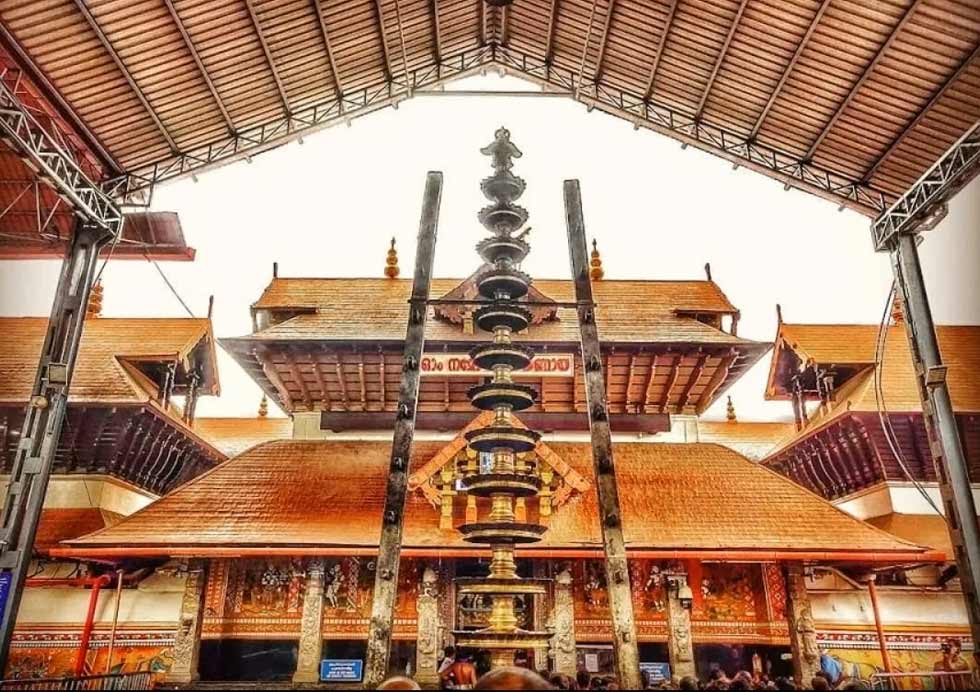
Before becoming a prominent pilgrimage site, Guruvayur served as a subordinate shrine of the Trikkunavay Shiva temple. However, the Dutch’s destruction of the latter in 1755 shifted the narrative, making Guruvayur the focal point of spiritual reverence. The story of a Pandyan King building a shrine here may trace back to the Azhavars, but historical texts remain silent on Guruvayur’s connection with them. It was Melpathur Narayana Bhattathiri’s Narayaniyam that catapulted Guruvayur to fame across India.
What sets Guruvayur apart is the form of the deity enshrined within – Guruvayurappan. Representing the Sampoorna Avatar of Lord Vishnu, the idol showcases the enchanting form of Bhagvan Vishnu with four lustrous arms, holding the conch Panchajanya, the discus Sudarshana Chakra, the mace Kaumodaki, and the lotus. Adorned with a divine Tulasi garland, the idol represents the majestic form of Maha Vishnu as revealed to Vasudeva and Devaki during Krishna Avatar.
The presiding deity in the sanctum-sanctorum is Mahavishnu, facing east, with a 4-ft tall idol. Despite its size, devotees affectionately consider it as Little Krishna. Guruvayurappan, as the devotees fondly call him, is identified as the “Father of Guruvayur” or the “Lord of Guruvayur” – a title that resonates deeply in South Indian languages.
What sets Guruvayur apart is the form of the deity enshrined within – Guruvayurappan. Representing the Sampoorna Avatar of Lord Vishnu, the idol showcases the enchanting form of Bhagvan Vishnu with four lustrous arms, holding the conch Panchajanya, the discus Sudarshana Chakra, the mace Kaumodaki, and the lotus. Adorned with a divine Tulasi garland, the idol represents the majestic form of Maha Vishnu as revealed to Vasudeva and Devaki during Krishna Avatar.
The presiding deity in the sanctum-sanctorum is Mahavishnu, facing east, with a 4-ft tall idol. Despite its size, devotees affectionately consider it as Little Krishna. Guruvayurappan, as the devotees fondly call him, is identified as the “Father of Guruvayur” or the “Lord of Guruvayur” – a title that resonates deeply in South Indian languages.

